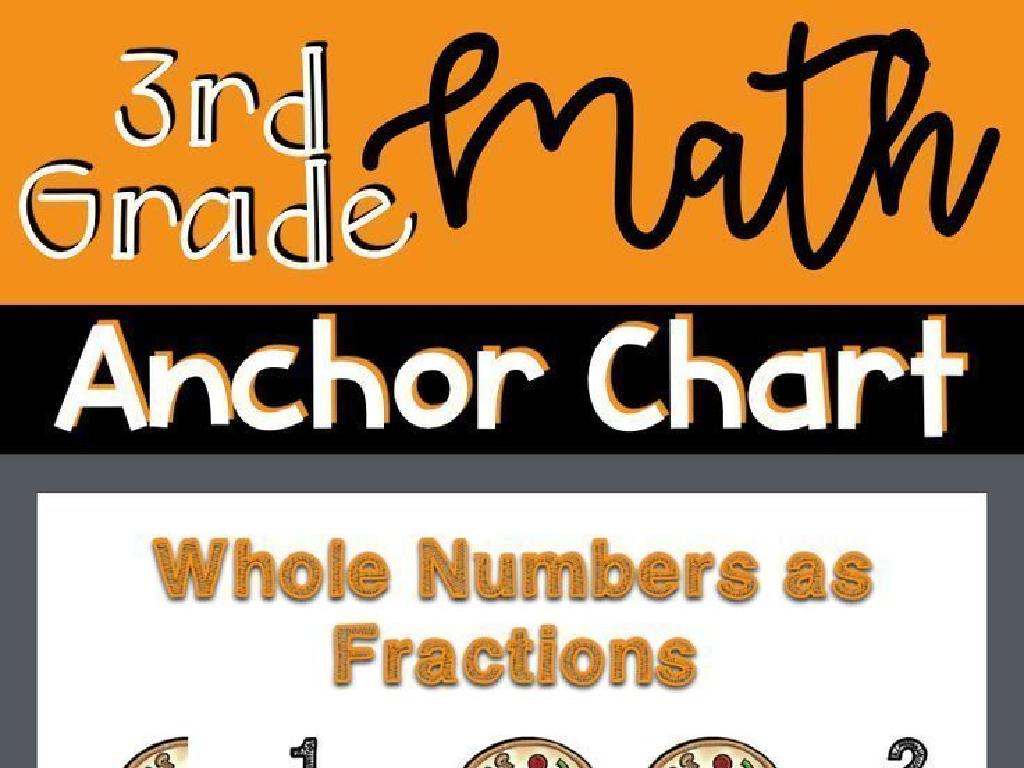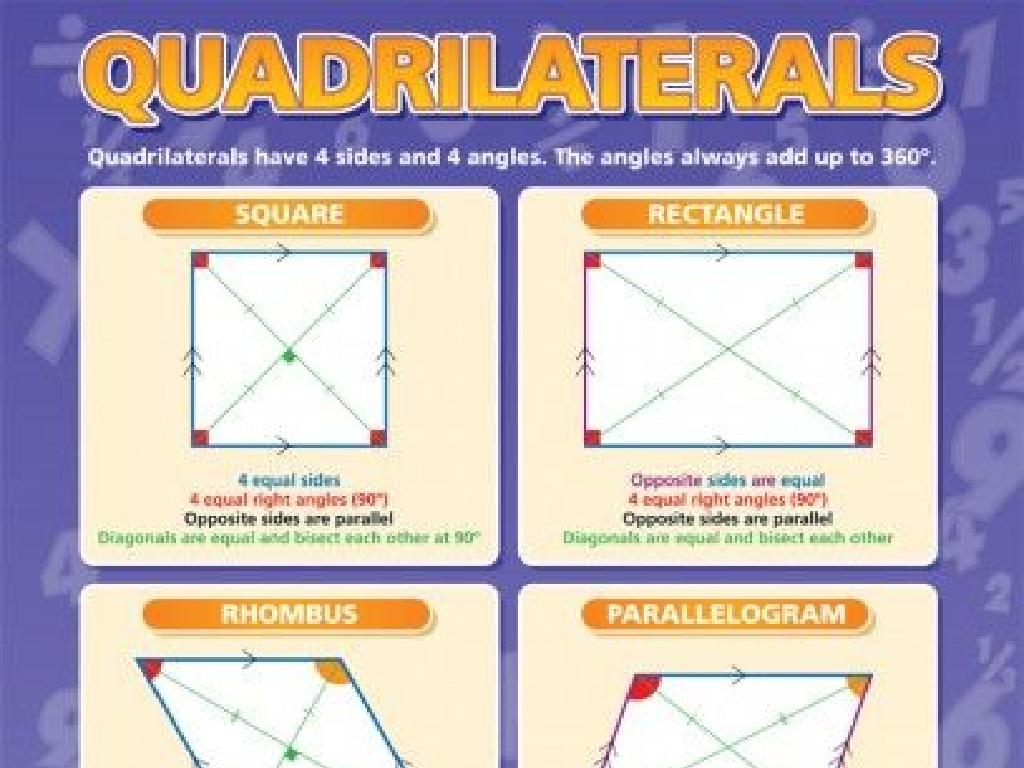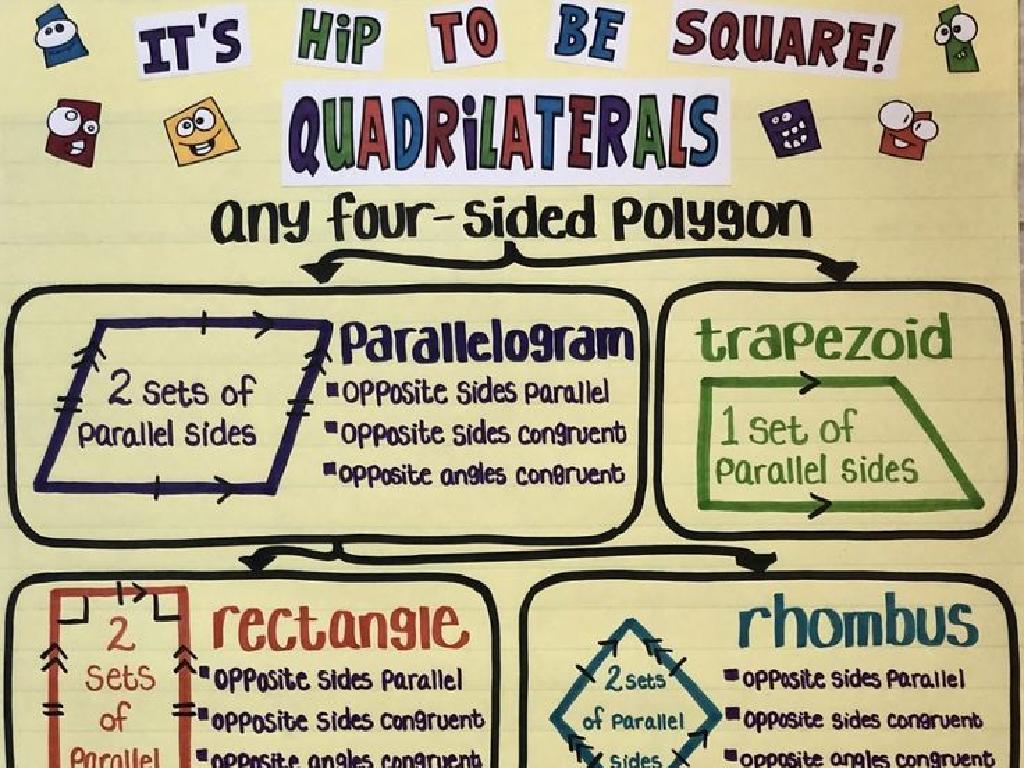Use Fractions To Find The Measure Of An Angle
Subject: Math
Grade: Fourth grade
Topic: Angle Measurement
Please LOG IN to download the presentation. Access is available to registered users only.
View More Content
Introduction to Angle Measurement
– Angles are everywhere around us
– Look at corners of a room, hands of a clock
– An angle is formed by two rays
– The point where they meet is called the vertex
– Angles are measured in degrees
– Think of a circle as 360 degrees
– Using fractions to measure angles
– Divide a circle into equal parts to understand
|
Begin the lesson by helping students notice angles in everyday objects, such as the corners of a room or the hands of a clock. Explain that an angle is created when two rays meet at a point called the vertex. Introduce the concept of measuring angles in degrees, with a full circle being 360 degrees. Use visual aids like a protractor or a pie chart to show how angles are fractions of a circle. This will set the foundation for understanding how to use fractions to find the measure of an angle, which will be explored in subsequent slides.
Understanding Fractions in Angles
– Recap: What is a fraction?
– A fraction represents a part of a whole.
– Fractions in daily life
– Pizza slices, a glass of water, sharing candies.
– Placing fractions on a number line
– Just like whole numbers, fractions have a place on the number line.
– Fractions in angle measurement
– Use fractions to describe part of a full turn in angles.
|
Begin with a quick recap of fractions, emphasizing that they represent parts of a whole, which is a concept students have encountered before. Provide relatable examples such as slices of pizza or a glass of water to illustrate fractions in everyday life. Then, introduce the concept of placing fractions on a number line, which helps in visualizing their value. Finally, explain how fractions are used in angle measurement, showing that just like a pizza can be divided into slices, a circle can be divided into fractions to describe angles. Encourage students to think of a clock face where each hour represents a fraction of a full turn (circle). This will set the foundation for understanding how to measure angles using fractions.
Connecting Fractions and Angles
– A circle’s total is 360 degrees
– Fractions show parts of a circle
– Think of a pizza cut into equal slices
– 1/2 a circle equals 180 degrees
– If you take half the pizza, that’s like 1/2 of 360 degrees
– 1/4 a circle equals 90 degrees
– Taking one slice out of four? That’s 1/4 of the whole circle!
|
This slide introduces the concept of measuring angles using fractions of a circle. Emphasize that a whole circle is 360 degrees, and fractions are a way to describe parts of this whole. Use relatable examples like slicing a pizza to help students visualize the concept. For instance, if a pizza (circle) is cut into two equal parts, each part represents half of the circle, or 180 degrees. Similarly, if it’s cut into four equal parts, each part represents a quarter of the circle, or 90 degrees. Encourage students to think of other fractions and corresponding angle measures to reinforce the concept.
Using Fractions to Measure Angles
– Using a protractor correctly
– Place the protractor’s center on the angle’s vertex
– Relate fractions to angle degrees
– Each degree on the protractor can be a fraction of a turn
– Practice with fractional angles
– Measure angles that aren’t whole numbers, like 45.5 degrees
– Understanding angle measurements
|
This slide introduces students to the concept of measuring angles using fractions and a protractor. Start by demonstrating the correct placement of a protractor on an angle’s vertex. Explain that each degree on the protractor represents a fraction of a full 360-degree turn. During practice, provide angles with fractional parts for students to measure, reinforcing the idea that not all angles are whole numbers. Emphasize the importance of precision when reading the protractor. Encourage students to think of the circle as a pie that can be divided into fractional parts, just like the degrees of an angle. This will help them visualize and better understand the concept of fractional angle measurements.
Real-Life Angles and Fractions
– Angles in everyday life
– Look at objects like books and tables
– Fractions describe angles
– A pizza slice cut into 4 pieces has an angle of 1/4 of a full circle
– Classroom angle hunt activity
– Find and measure angles around the class using a protractor
– Discuss angle findings
– Share the angles you’ve found with the class
|
This slide introduces students to the concept of finding and measuring angles in real-life objects, emphasizing the use of fractions to describe these angles. Encourage students to think about how many everyday items, like books, tables, and pizza slices, have angles that can be measured. The activity involves students identifying and measuring angles within the classroom, using a protractor, and then using fractions to describe the size of the angles they find. After the activity, students will discuss their findings, reinforcing their understanding of angle measurement and fractions. Prepare to provide examples of objects with clear angles and ensure there are enough protractors for the activity. Consider grouping students and assigning different angles to each group for a more collaborative learning experience.
Class Activity: Angle Scavenger Hunt
– Find classroom objects with angles
– Measure angles using fractions
– Use a protractor to measure the angle in fractions of a circle
– Record your angle measurements
– Share findings with the class
– Discuss how different objects have different angle sizes
|
This interactive activity is designed to help students apply their knowledge of fractions in measuring angles. Provide each student with a protractor and encourage them to find various objects around the classroom that have clear angles, such as desks, bookshelves, or windows. Guide them on how to measure angles using the protractor and express these measurements as fractions of a circle (e.g., 1/4 turn for a right angle). Have them record their findings on a worksheet. After the scavenger hunt, ask students to share their measurements with the class, discussing how they used fractions to express the angle sizes. This will reinforce their understanding of both angle measurement and fractions. Possible variations for different students could include finding acute, obtuse, and right angles, or even estimating angles before measuring to incorporate estimation skills.
Conclusion: Angles and Fractions
– Recap angle measurement
– How we use fractions to measure angles
– Significance of angle knowledge
– Angles are everywhere: in art, buildings, and even sports!
– Engage in Q&A activity
– Summarize today’s lesson
– Review key points and clarify doubts
|
This slide wraps up the lesson on measuring angles using fractions. Begin by reviewing the methods used to measure angles and how fractions play a role in this process. Emphasize the importance of understanding angles in various aspects of daily life, such as architecture, art, and sports, to illustrate why this knowledge is valuable. Conduct a Q&A session to address any uncertainties students may have, ensuring they feel confident about the topic. Finally, summarize the key points covered in today’s lesson to reinforce learning and provide a clear conclusion.





